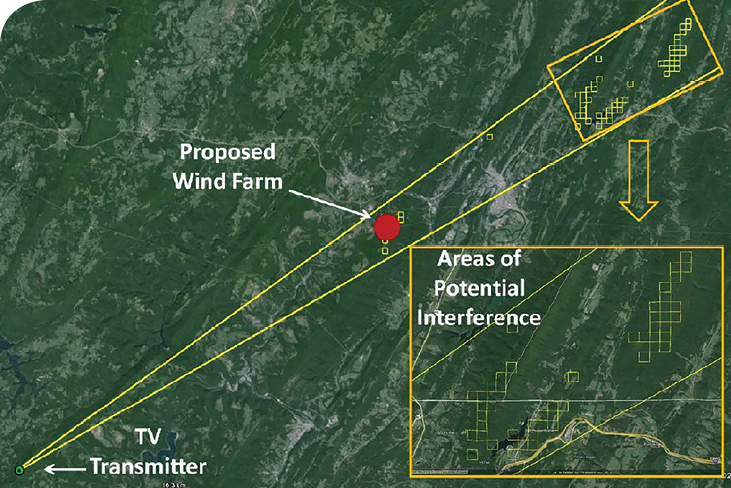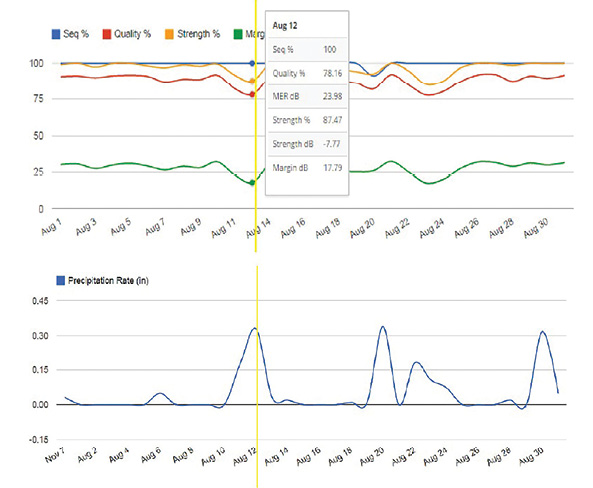After a site assessment collects sufficient and bankable wind data, a project closes on financing and allays wildlife concerns. Other than the upcoming site construction, there seems little else to worry about. But as wind farms become more numerous, one concern not often discussed in the industry is the potential for wind-farm interference with TVs, radios, and emergency broadcast transmissions.

The yellow lines define an areas of potential interference to television signals. It is also one output of Marlowe’s software. The cells in the (inset) Area of potential Interference are where the simulated signal strength dropped from a pre-construction value above 60 dBμV (decibels above 1 microvolt/meter) to below 45 dBμV post construction.
Broadcast Wind’s Frank Marlowe says an accurate pre-construction characterization of potential interference to television and radio transmissions is vital to the success of a wind-energy project. TV and radio broadcasting signals are especially critical because they can directly impact local populations.
Marlowe has a solution to the problem of estimating changes to important transmission signals by predicting the effects of proposed wind farms on them. “We recommend a pre-construction analysis for several types of broadcast transmissions to avoid accidentally placing turbines in obstructing locations. Wind-farm developers and other interested stakeholders, such as permitting agencies and investors, find the evaluations useful,” he says.
Marlowe uses a computer-based simulation to assess the potential for signal impairment. Simulations of signal strength from TV stations that cover the area include the proposed wind farm and regions around the proposed site. “Electromagnetic-wave-propagation software simulates signal strength over a 3D terrain model. Individual wind turbines are modeled as features in the terrain. This allows comparing field strengths with and without the turbines,” he says.

The example dashboard shows correlation between precipitation and variations to a UHF digital television signal. High wind, time of day, and seasonal changes can also play roles in signal propagation. The inset box provides measurement data for a particular time of day.
To make signal strength measurements, the company uses proprietary, stationary remotely-monitored RF probes. These provide wind-farm developers and stakeholders with long-term TV-signal strength and signal-quality data at critical locations. The probes capture TV-signal metrics through changes in seasons and atmospheric conditions before, during, and after wind-farm construction.
With data from the probes, Marlowe’s software can simulate transmissions and then calculate three important metrics on a dashboard as a percent scale. The metrics include:
- The TV signal “SEQ” tells whether the video signal is watchable or not. An SEQ of 99% would mean that the viewer sees a “hit” or pixilation to the video 1% of the time.
- Signal strength in dBmV (decibels above 1 microvolt/meter) and signal quality (MER) in dB are also calculated.
- “Margin” describes how much signal strength buffer there is in dB above the threshold of operation. More margin means a stronger, more stable video signal. A fourth metric, margin or signal strength buffer, is displayed in decibels (dB).
In addition to TV signals, Marlowe suggests examining potential interference with AM and FM radio stations, point-to-point and point-to-multipoint microwave systems, land mobile and emergency services, commercial Doppler and government radar, and others. A more in-depth discussion on this topic is here: The bigger picture.
For a digital copy of the entire August issue of Windpower Engineering & Development, pick here: http://goo.gl/9dlckH
Filed Under: Construction, News




